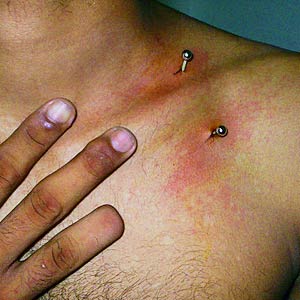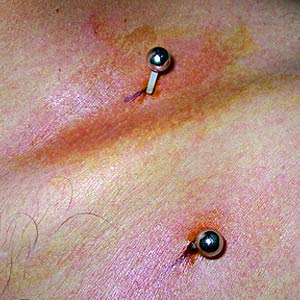Sub-Clavicle Piercings
WHYNOTHOWTO
“A learning experience is one of those things that says, ‘You know that thing you just did? Don’t do that.’”
- Douglas Adams
Clavicle piercing by IAM:alienx
Hot on the heels of Gillian’s exposé on horizontal tongue piercings, I too decided to dip my toes into the investigative journalism pool. As well, since co-opting other peoples’ ideas is generally infinitely easier than coming up with your own, I figured that working — once again — with the topic of unique and potentially troublesome piercings was going to be the ticket. The task at hand, however, was not as light and breezy as I had been expecting.
After numerous sleepless nights, I arrived at my editor’s office with a lengthy list of body parts that, if pierced, would likely give their wearer a rough ride. Sadly, I was informed that the majority of the locations I’d listed had not existed on any human body for several evolutionary cycles, and furthermore, that much of my list was actually just the lyrics to Dark Eyed Cajun Woman by The Doobie Brothers. Additionally, it was asked of me exactly how I spent $14,000 of the company’s money compiling this, but, undeterred, I made it clear that I wasn’t there to talk about the past; I wanted to discuss the future. After a mild beating, it was decided that I would be scouring the earth for information pertaining to one of the piercing community’s greatest enigmas and anomalies: The sub-clavicle piercing.


Clavicle surface piercings |
Don’t mistake this with surface piercings that reside on top of the collar bone area; a sub-clavicle piercing passes beneath the collar bone, giving this piercing the unique characteristic of being the only one that penetrates the inner body cavity. Consequently, this also gives it the unique characteristic of being one of the most potentially dangerous piercings, innocuous as it may seem. “There are two veins running at each end of the clavicle bone — you can generally see them when you tense up around that area,” says Sarge (IAM:Sarge), “[and] of course, it’s a risk having anything piercing an actual body cavity as it can be prone to infection.” Currently residing in the Dorset region of the United Kingdom and operating out of his Metal Fatigue shop in Bournemouth, Christopher Sargent (“Sarge”) has been in the industry since 1989. While he doesn’t place himself in the realm of what he calls “some of the awesome artists on BME”, he is most certainly a talented, accomplished piercer, has dabbled in branding, scarification and implants, and helps run the Metal Fatigue Collective suspension crew. For the purposes of this article, he is also arguably one of the most proficient practitioners of the sub-clavicle piercing in the world.

D’argo’s inappropriate
jewelry |
“The first one I did was on a guy named Luke while I was [working] at the White Flame Tattoo Studio in 2001,” Sarge explains, “[and] I was really unsure about how to undertake it at first. I’m well into anatomy books though, so between Gray’s Anatomy and some Internet research, I just ploughed through a lot of info at the time. I found Gunther Von Hagens’ Body Worlds work very helpful as well. We called it the Farscape piercing at first — after D’argo, a character from the show that’s got two big rings [in the same spot]. Luke actually wanted the piercing done with rings at first, but I had to talk him out of it! As well, I always use PTFE when performing this piercing, and always too much — it gets in the way a bit, but the piercing takes a few weeks to anchor itself. Oh, and large balls! The last thing you need is any embedding.” It’s certainly a testament to the rarity of a piercing when having done it on only eight people can bestow “expert status” upon someone, but Sarge has come as close as possible to perfecting his routine — the first step was determining what kind of anatomy was suitable for this project. “It really does depend on anatomy,” he explains, “if you can’t suck in and jut out your collarbone so that you can literally pinch around it, there’s no way it can be done. When I pierce the area, I’m not using a curved needle — I’m going through about an inch of flesh, and I need to be able to feel where the needle is going to be going in and where it’ll be coming out. And since there’s no way you can shine a light through the area, all you have to work with [as a piercer] for this piercing is anatomical data.”
Kayleigh (IAM:Kay) is a client of his, and is one of the few people who has been able to hang onto her sub-clavicle piercings, having now had them for close to two years. After seeing pictures of some of Sarge’s earlier trials on BME, she found the sub-clavicle piercing to be the “most beautiful piercing [she’d] ever seen”, though she didn’t get it done herself until a few years later. While she enjoyed the novelty factor of the piercing, “I really liked the placement of them,” she explains, “it seemed like a pretty place to have a piercing, and I couldn’t stop playing with my collarbones after I saw the photos.” The procedure, she found, was rather straightforward: “It wasn’t really any different from your average piercing,” she claims, “I think all the same equipment was used; [he cleaned the area with an antiseptic and marked the entry and exit points], and basically I leaned my arm forward to make my collarbone stick out, the needle went from the bottom of the bone, underneath it, and came out just above the bone. I’m sure it sounds more complicated than it was!” As for jewelry, Kay was outfitted with a “1.6mm PTFE bar, just like I’ve had for all my surface piercings,” she says, “though I had one of them changed when I needed a slightly longer piece. It was getting a bit uncomfortable when it came to sleeping, and I obviously didn’t like waking up in the middle of the night because of the pain.”
In spite of having been able to keep her sub-clavicle piercings for a number of years, though, the process has not been without its setbacks. Even after following Sarge’s aftercare regimen (twice a day for two to three weeks, holding a piece of paper towel soaked in saline solution to the piercing for two to three minutes to soften any dried matter, then using a fresh piece of paper towel — also soaked in a saline solution — to wipe the piercing down with afterwards), Kay maintains that “healing them was definitely annoying”. She goes on: “In the first month I had to take time off of work because they would bleed whenever they felt like it; customers didn’t appreciate the fact that it looked like I’d been shot.” Even now, the piercings have not fully healed, and Kay is not sure that they ever will: “They still weep slightly, and I’m always aware of them. It doesn’t really bother me, but they can be a pain sometimes.”
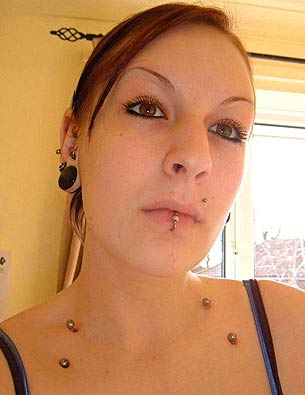
Kayleigh (IAM:Kay)
Natalie Free, a 22 year old student at Lipscomb University in Nashville, Tennessee, has had trouble healing hers as well. “I’m not sure [that it ever fully healed]. It’s scarred a lot and moved around quite a bit, which could be because my barbell is metal and not something flexible.” Also a fan of the piercing via images in BME’s galleries, Natalie approached piercer Jason Stamphley of the Nashville shop Quest to do the procedure. Stamphley was confident that he could do it and, according to Natalie, “a little excited about doing something so dangerous and rare.” Trusting Stamphley, she figured that “there were other people out there that had it done, so it couldn’t be that bad.” Rather than doing the procedure in his shop though, he suggested that it be done in a hotel room; Natalie declined that idea and offered up her own apartment, to which he brought “a tackle box full of piercing and sanitation stuff.”
The piercing itself, Natalie says, was relatively painless — a claim that Kayleigh backs up as well, with the sensation of “something going under the bone and popping out the other side” being “weird” as opposed to “painful”. “I leaned back against the wall,” Natalie explains, “and after sterilizing the area, he pierced me with a long curved needle that resembled a fishing hook. He took a moment, and then simply ran the barbell through directly after [the needle] — it looked so hardcore!” Unfortuantely however, the jewelry choice — a one-and-a-half inch stainless steel curved barbell — was poorly received by Natalie’s body. While it was a perfect fit immediately following the procedure, the next morning found her in excruciating pain, unable to get much mobility out of her arm — even opening her mouth too wide would send surges of pain through her shoulder. Following Stamphley’s simple aftercare advice, after gently washing and rinsing the piercing, Natalie took some Ibuprofen and vitamin K “so as not to bleed too much.” The pain subsided, but swelling had engulfed much of the too-short barbell, with the bottom bead entirely swallowed by her swollen skin. The piercing, of course, was removed, but Natalie was determined to try again. Returning to Jason, the second try was done inside Quest with a three-inch curved barbell — the piece of jewelry that she still wears today. “The day after [the second attempt] wasn’t as bad,” she claims. “It bled for about a day, but that was it — though it stayed sore for a really long time. About a week and a half after the piercing took place I wanted to go jogging, but jostling it too much really hurt; I couldn’t even lift my arm to get my sports bra off, and had to cut it off with scissors. Now though, I’m only occasionally aware of it. I only really notice it at night if I roll over onto that side, but it’s more uncomfortable than it is painful.”
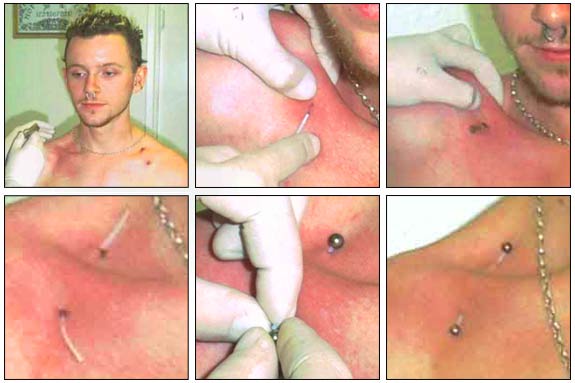
Luke gets his clavicle pierced by Sarge.
Natalie isn’t the only one to give the piercing a second chance: Kayleigh, who has both clavicles pierced, woke up one morning to find that a bead on the left side had come unscrewed and, as a result, the barbell had come out and couldn’t be put back in. Needless to say, she bit the bullet and got it re-done. “I wouldn’t do it again though,” she claims, “I still think they’re beautiful, but I think they’ve had their chances.”
Clients aren’t the only ones with mixed feelings regarding these piercings; Nick Anzalone (IAM:Hotpiercedguy), head piercer and manager at Seattle’s Under The Needle studio, sees no need to rush into them. “[The sub-clavicle piercing] falls under a ‘wait’ category for me,” Anzalone explains. “There are a lot of heavier mods that, if I am asked to do them, I make the client keep asking for a long period of time to hopefully ensure that they really want it. [With] all four of the clients I’ve done this piercing on, I did my best to scare them by telling them the worst-case scenarios — infection obviously being my number-one concern — but I’ve kept in contact with each of them, and nothing like that has happened.”
Sarge’s clients have had good luck as well, but regardless of that fact, he has ceased performing the piercing altogether — no matter how frequent or demanding the requests. “I’m really polite about it,” he says, “but I just explain how it is — that it’s a risk that I’m personally no longer willing to put people through. Now I do a lot of clavicle surface piercings instead, and offering that as an alternative seems to keep most people happy.”


Christopher Sargent
(IAM:Sarge)
|
“The biggest danger Sarge told me about was, if done incorrectly, it could puncture a lung,” says Kayleigh, “but I was also told that if it were pierced from bottom to top, there wouldn’t be a problem.” This, however, may not necessarily always be true.
“Everyone’s anatomy is different,” explains Tyler Welch, a Clinical Exercise Physiology student currently attending Montreal’s Concordia University . “The apex of your lung is pretty close to your clavicle, though it’s more behind the medial third of the it — towards the midline of your body. If the piercing is being done more laterally — towards the shoulder, that is — it shouldn’t be a problem. Again though, there’s a certain degree of variation from person to person, so the apex of one person’s lung may be different than another person’s. As a rule though, stay as far from the midline of your body as possible.”
Many sub-clavicle piercings, luckily, are performed in this fashion, but what are the other risks of piercing this sensitive area? Welch goes on: “The subclavian artery and the brachial nerve plexus all run underneath the clavicle, supplying blood and innervating the muscles and sensations for the entire arm. If you pierce either one of these major vessels, you’re going to get a ton of bleeding. Furthermore though, if significant damage is done to the nerve, permanent nerve damage is a definite possibility; maybe you won’t be able to move your arm or only be capable of excessively weak movements, maybe you’ll lose all sensation in your arm, or a combination of the two. It depends on what part of the brachial plexus you’ve damaged; this is a bundle of nerves that spreads out just past your shoulder towards your arm, and given the injured section, different parts (or all) of the limb may be affected.”
Michael Zettler, an Honours Health Sciences student at McMaster University in Hamilton, Ontario, though, is less concerned with nerve damage than he is with the potential for infection. “To do this piercing, you’d almost definitely be going through some muscles — probably the pectoralis major, and possibly some smaller ones from your neck. The subclavian artery and the brachial plexus are both pretty deep though, and you probably wouldn’t pierce them. However, your muscles have a lot of blood flowing through them; if your pectoralis muscle got infected, the blood drainage could spread the infection very quickly.”
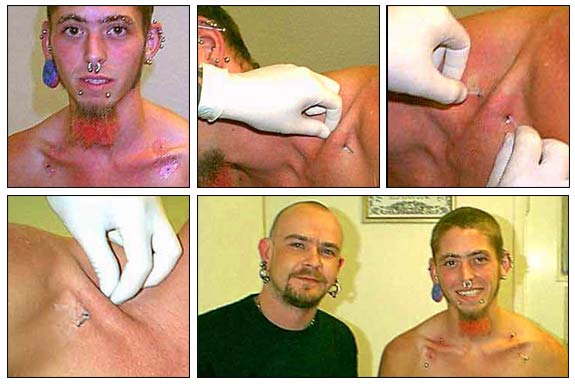
Sarge pierces Ben’s clavicles.
Welch adds: “With most piercings, you’re only going through the superficial layers of skin which aren’t very vascularized — that is, they contain few if any blood vessels — but the deeper you go, the more vessels you’ll find, and the more vessels you find, the greater the chance of compromising them. If this occurs, an infection would be quicker to spread and become a serious systemic problem — one that affects your entire body. Whereas, with superficial piercings, you’re much further from the vessels, and an infection is therefore more likely to stay confined to a small area and not require treatment with systemic antibiotics or anything.”
“It’s also important to note,” says Zettler, “that your skin can always grow back, but muscle cells don’t divide. So once you’ve lost them — whether from piercing them or from a subsequent infection — you’re not getting them back. They’re gone for good.”
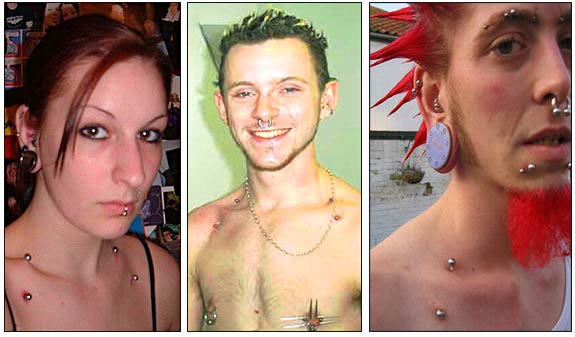
Kay, Luke and Ben are Sarge’s only clients who have kept their sub-clavicle piercings.
After a heyday of clients and practitioners in the community feeling more qualified to ascertain the potential problems of piercings than those in the medical field (and admittedly, doctors and the like have habitually over-reacted to this kind of thing), as we move towards substantially more dangerous terrain, perhaps it is a good idea to heed their advice on matters such as this. After an endless amount of “tongue studs and septum piercings give you brain cancer” doomsday scenario-type stories, it’s certainly natural to take the warnings of the medical community with a grain of salt. The sub-clavicle piercing is fundamentally different, however, than any other piercing in even quasi-common practice, and should be treated with extreme caution. It seems, however, that in many ways it is not given the distinction it requires; in the scope of the entire piercing world, really only a handful have been done, and few have ever fully healed. The question is, is it worth it?
“Absolutely,” insists Natalie, “I was so determined to have it that I let the piercer do it twice! It’s kind of like a conversation piece, and honestly, I can’t imagine not having it now.” Kayleigh agrees, maintaining that they’re beautiful “even when they’re a bit crusty”. And while there isn’t necessarily an end in sight, both girls admit that there will likely come a day when the piercings have to be removed.
“I’m going to see how they are in another year or so,” says Kayleigh, “and if they still haven’t healed I’ll probably just take them out.”
“It will be a sad day,” Natalie acknowledges, “but I think I will just outgrow it eventually. It would definitely make it more comfortable for me to lie on that side.”
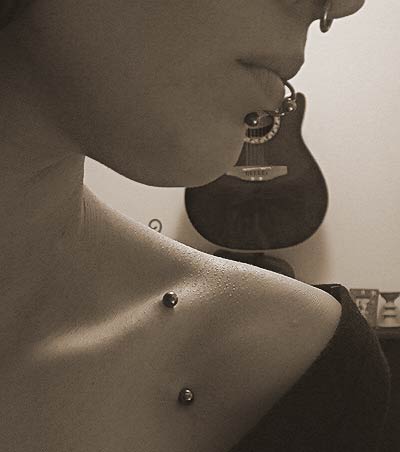
IAM:Nny
And it is a shame — it’s a pretty stunning piercing to see. On the whole though, because there are so many variables at stake here that are more difficult to control than with most other piercings, the wisest course of action may in fact be, as Sarge is doing, letting the issue rest until safer, more effective placement and healing methods can be developed. Again, at the very least, extreme caution must be exercised if it is being attempted, and one must acknowledge that this is a much more serious piercing than meets the eye.
“I think it’s a great piercing,” Sarge admits, “and it looks fantastic when it’s healed. But my God, you’ve got to go through a couple of years of hell to get there!”
- Jordan Ginsberg (iam:snackninja)
IAM members click here to discuss or comment on this article
|
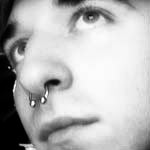
A recent acquisition from the illustrious, high-profile world of low-budget
sporting-goods photography, Jordan Ginsberg is a Toronto native. Born
affiliated to the Levi tribe, Jordan renounced his religion shortly before
his Bar Mitzvah but still believes he is entitled to a role in the liberal
Jew-run media and sees BME as an ideal stepping stone. Votes left, throws
right.
Article copyright © 2005 BMEZINE.COM. First published April 20th, 2005 in La Paz, BCS, Mexico. Requests to reprint must be confirmed in writing.
|


